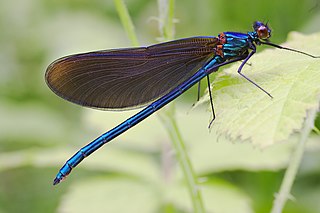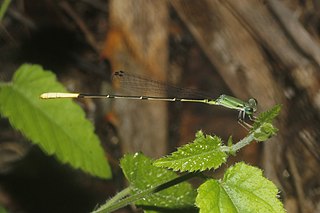
Calopterygidae is a family of damselflies, in the suborder Zygoptera. They are commonly known as the broad-winged damselflies, demoiselles, or jewelwings. These rather large damselflies have wingspans of 50–80 mm, are often metallic-coloured, and can be differentiated from other damselflies by the broader connection between the wings and the body, as opposed to the abrupt narrowing seen in other damselfly families. The family contains some 150 species.

Argia is a genus of damselflies of the family Coenagrionidae and of the subfamily Argiinae. It is a diverse genus which contains about 114 species and many more to be described. It is also the largest genus in Argiinae. They are found in the Western Hemisphere. They are commonly known as dancers. Although the genus name comes from Ancient Greek: ἀργία, romanized: argia, lit. 'laziness', dancers are quite active and alert damselflies. The bluer Argia species may be confused with Enallagma species.

The Pseudostigmatidae are a family of tropical damselflies, known as helicopter damselflies, giant damselflies, or forest giants. The family includes the largest of all damselfly species. They specialize in preying on web-building spiders, and breed in phytotelmata, the small bodies of water held by plants such as bromeliads.
Amphipteryx agrioides, the montane relict damsel, is a species of damselfly in family Amphipterygidae. It is found in Guatemala, Honduras, Mexico, and possibly Colombia. Its natural habitats are subtropical or tropical moist montane forests and rivers. It is threatened by habitat loss through deforestation for coffee plantations and cattle ranching.
Amphipteryx longicaudata was a species of damselfly in family Amphipterygidae. It is endemic to Mexico. Its natural habitats are subtropical or tropical moist montane forests and rivers. It is threatened by habitat loss. It is now a synonym of Amphipteryx agrioides.

Calopteryx is a genus of large damselflies belonging to the family Calopterygidae. The colourful males often have coloured wings whereas the more muted females usually have clear wings although some develop male (androchrome) wing characteristics. In both sexes, there is no pterostigma.

Chlorocypha is a genus of damselflies in the family Chlorocyphidae.
Diceratobasis is a genus of damselfly in the family Coenagrionidae. The larva of species in this genus live in water that is trapped in bromeliads.

Dicterias is a monotypic genus of damselflies in the family Dicteriadidae. It contains the single species Dicterias atrosanguinea, which is known commonly as the red bareleg. It is endemic to Brazil. It occurs on the banks of the Amazon River.

Hetaerina is a genus of damselflies in the family Calopterygidae. They are commonly known as rubyspots because of the deep red wing bases of the males. The name is from Ancient Greek: ἑταίρα (hetaira), courtesan. H. rudis, the Guatemalan rubyspot, is considered vulnerable on the IUCN Red Data List.

Leptobasis is a small genus of damselflies in the family Coenagrionidae. They are commonly known as swampdamsels. The genus is neotropical and one species, L. melinogaster, has been recorded in Texas. They are slender and the females have very long ovipositors.

Neoneura is a genus of damselfly in the threadtail family Coenagrionidae. They are found in the Neotropics, from Cuba and Texas to Argentina.

Paraphlebia is a genus of flatwings in the damselfly family Thaumatoneuridae. It was formerly in the subfamily Argiolestinae of the family Megapodagrionidae, but was moved to the family Thaumatoneuridae as a result of molecular phylogenetic studies by Dijkstra et al. in 2013.
Platycnemis agrioides is a species of damselfly in the family Platycnemididae. It is endemic to Mayotte. Its natural habitats are subtropical or tropical moist lowland forests and rivers. It is threatened by habitat loss.

Platycnemis is a genus of damselfly in the family Platycnemididae.

Platycypha is a genus of African damselflies in the jewel damselfly family (Chlorocyphidae).

Prodasineura, the Asian threadtails, is a genus of damselflies in the family Platycnemididae. All the Afrotropical species formerly in this genus are now placed in Elattoneura, the African threadtails. Dijkstra et al. (2014) moved the genus from Protoneuridae to Platycnemididae based on molecular phylogenetic research.
Rimanella is a monotypic genus of damselflies, the only genus in the family Rimanellidae. It contains the single species Rimanella arcana. This damselfly is known commonly as the Pantepui relict damsel. It is native to South America, where it occurs in Guyana, Venezuela, Suriname, and Brazil.

Diphlebia euphoeoides, sometimes spelled Diphlebia euphaeoides, known as the tropical rockmaster, is an Australian species of broad winged damselfly. It is one of a group known as the azure damselflies. It is found in Queensland (Australia) and Papua New Guinea. It typically occurs near lakes, waterfalls or streams at relatively low altitudes, and is occasionally seen near dry pools.
Devadatta is a genus of damselflies in the family Devadattidae which is a sister-group of the Chlorocyphidae. There are about 13 described species in Devadatta.












